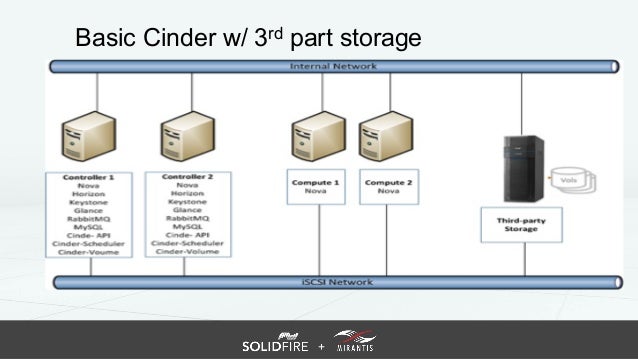
Solidfire download iso - charming
Have not: Solidfire download iso
| WHERE TO DOWNLOAD WINDOWS DRIVERS | 803 |
| DOWNLOAD NARUTO ULTIMATE NINJA STORM 4 MODS | 360 |
| ROBBINS GET THE EDGE FREE PDF DOWNLOAD | 55 |
| DOWNLOAD TURBO VPN FOR WINDOWS 7 PC | 636 |

Sunday, 25 November 2018
Creating Bootable USB Sticks to RTFI* NetApp HCI Nodes
*RTFI = Return to Factory Image


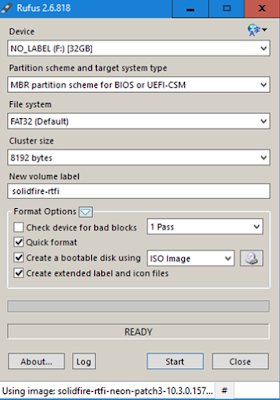
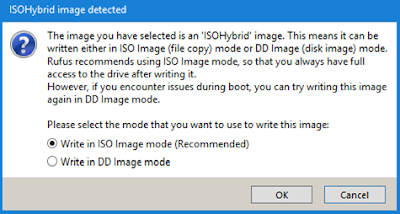
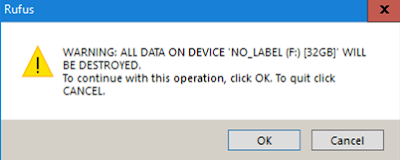

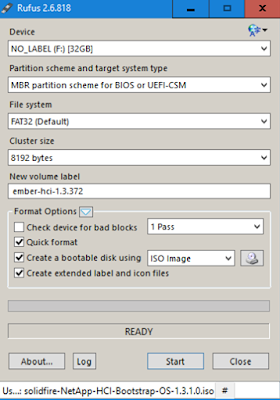
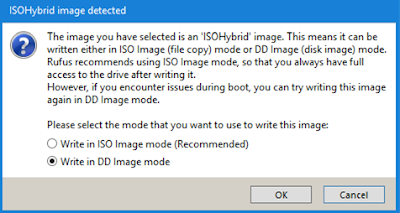
I needed to prep some USB sticks ready for an upcoming NetApp HCI install. There are various reasons why you might want to RFTI: reset a test/demo/lab environment, apply the latest versions, someone’s muddled the disks up...
Firstly, you will need a bootable USB drive maker. Go to:
And download rufus-2.6p.exe. I know 2.6 works for this purpose (I had issues with 3.3). The ‘p’ is for ‘portable’/don’t-need-to-install which I prefer, but you don’t have to go for the ‘p’ version.
Secondly, you will need to get the NetApp HCI compute and storage node images from (Product = ‘NetApp HCI’):
The ISOs are quite big. Storage node ISOs are ~4GB and Computes node ISOs ~ 15GB (mainly because it contains a few different versions of VMware vSphere).
Here I’m using NetApp HCI 1.3.1 ISOs:
- solidfire-rtfi-neon-patch3-10.3.0.157.iso (Storage Node)
- solidfire-NetApp-HCI-Bootstrap-OS-1.3.1.0.iso (Compute Node)
Image: NetApp HCI Storage and Compute Node ISOs

Step 1) Double-Click rufus-2.6p.exe to run

Step 2.1) Enter settings into Rufus as thus:
First check ‘Create a bootable disk using...’ and click the CD icon to the right, and point to the solidfire-rtfi-neon-patch3-10.3.0.157.iso (or whatever version you’re using).
Partition scheme = MBR partition scheme for BIOS or UEFI-CSM
File system = FAT32 (Default)
Cluster size = 8192 bytes
New volume label = solidfire-rtfi
Uncheck ‘Check device for bad blocks’
Check ‘Quick format’
Already checked ‘Create a bootable disk using...’
Check ‘Create extended label and icon files’
Image: Rufus Settings for Storage Node

Step 2.2) Select ‘Write in ISO Image mode’
Image: ISOHybrid image detected - Write in ISO Image Mode

Step 2.3) Click OK to the warning
Image: ALL DATA WILL BE DESTROYED!

Step 2.4) Wait for Rufus to finish!

This will probably take about 5 minutes.
Setting up Rufus for the Compute Node RTFI USB drive is pretty much the same as for the Storage Node, except you must choose ‘Write in DD Image mode’ (IMPORTANT!)
You will need to point to the solidfire-NetApp-HCI-Bootstrap-OS-1.3.1.0.iso (or whatever version you’re using).
I let the ‘New volume label’ autopopulate with ember-hci...
Image: Rufus Settings for Compute Node

Image: ISOHybrid image detected - Write in DD Image Mode

It took a good 40 minutes (on my system) to create the Compute Node RTFI USB drive.
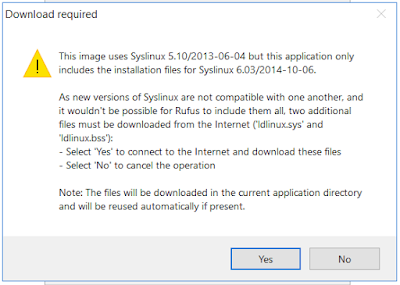
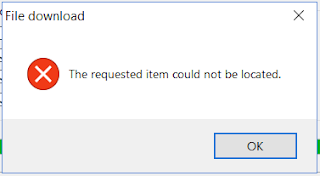
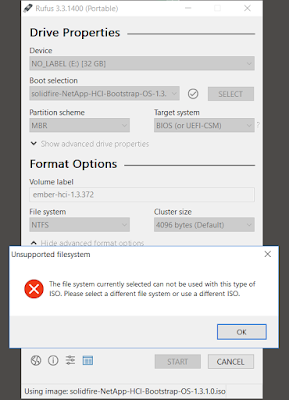
Bonus Material 1 of 2: Correct Syslinux Version
One problem you’ll have with Rufus 2.6, is that it cannot download the correct versions of Syslinux, and you’ll get “The requested item could not be located”. My trick was to use Rufus 3.3 to download the correct versions of Syslinux.
Image: Syslinux 5.10/2013-06-04 is required

Image: Rufus 2.6.818 - “The requested item could not be located.”

Bonus Material 2 of 2: Why Not Use Rufus 3.3?
Rufus 3.3 works fine for the Storage Node, but not the Compute Node. Trying to create the USB key for the Compute Node, you’ll get stuck because you can’t select anything other than NTFS for File System, and when you click START, get the error message: “Unsupported filesystem: The file system currently selected can not be used with this type of ISO. Please select a different file system or use a different ISO.”
Image: Rufus 3.3.1400 - “Unsupported Filesystem”

Tuesday, 20 November 2018
If you’re headswapping to AFF A700 / A700s you might need more disk...
Some of the original NetApp AFF (All Flash FAS) platforms are reaching the age where one might consider headswapping them. One of the first things we check before any headswap (this was the same for 7-Mode headswaps) is that the root volume is of sufficient size to support the new platform, and if the root volume is too small, we make it bigger before commencing the headswap.
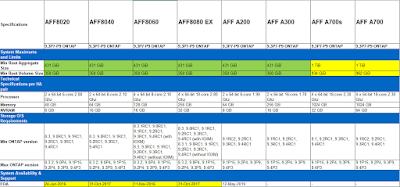
The AFF8020 / AFF8040 / AFF8060 / AFF8080EX have min. root volume size of 350 GiB.
The AFF A200 / A300 have min. root volume size of 350 GiB.
The AFF A700s / A700 have min. root volume size of 934 Gib / 962 Gib.
So, if you want to headswap to an AFF A700s / A700, and you had ADP RD2 partitioned root aggregates, and the root aggregate size is less than the minimum root aggregate size - which is 1 TiB - for the AFF A700s / A700, then you might need to add more disk so can you can create a root aggregate big enough to hold the root volume.
Image: HWU for NetApp AFFs with ONTAP 9.3P7-P9

Saturday, 17 November 2018
NetApp HCI: Some Notes, References and Links
I‘ve not posted anything about NetApp HCI since July 2017 (my first and only dedicated post), so about time to update!
RTFI
If you have a need to RTFI the nodes (i.e. a new version of the NDE has come out and you want to use the latest), then go to https://kb.netapp.com/ and search for RTFI. To create bootable USB keys you can use the Rufus tool from https://rufus.ie/en_IE.html (can RTFI from the IPMIs also).
Note: If I get around to it I'll do a post on preparing bootable USB keys. The process is a little different for the compute and storage nodes.
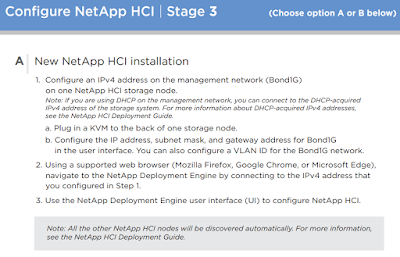
Note: The below is correct at time of writing (mid-November 2018)
NetApp HCI Installation Workbook
This is something a customer will be sent prior to a NetApp/Partner Professional Services installation engagement. Essentially it is to make sure the environment and required information (network switches, DNS, NTP, IP address, VLANs, etcetera...) is ready prior to the PS Engineer arriving on site.
The HCI software is pre-loaded on the nodes, but if they shipped on a previous version and you want the latest, or perhaps you’re testing and want to blat it to start anew:
From the above you can download:
Software download for NetApp HCI compute node:
solidfire-NetApp-HCI-Bootstrap-OS-1.3.1.0.iso
Software download for NetApp HCI storage nodes, Element OS:
solidfire-rtfi-neon-patch3-10.3.0.157.iso
Software download for NetApp HCI management node:
solidfire-NetApp-HCI-mNode-1.3.0.8.ova
(Other) NetApp HCI Software
NetApp Interoperability Matrix Tool
Solution Search > Converged Infrastructure > NetApp HCI
Briefly - supported includes:
- VMware ESXi 6.0 U3 / 6.5 U1 / 6.5 U2 / 6.7
- Element OS 10.0 / 10.1 / 10.2 / 10.3 / 10.4
*See VMware HCL for all Guest OSes that are supported.
NetApp HCI: It’s So Easy, It’s Almost Anti-Climactic
NetApp HCI: The first installation. The force awakens (and it glows)
NetApp HCI: Your Biggest Questions Answered
NetApp HCI YouTube Videos
General Technical Reports:
Solution Specific Technical Reports and NetApp Verified Architectures
RTFI
If you have a need to RTFI the nodes (i.e. a new version of the NDE has come out and you want to use the latest), then go to https://kb.netapp.com/ and search for RTFI. To create bootable USB keys you can use the Rufus tool from https://rufus.ie/en_IE.html (can RTFI from the IPMIs also).
Note: If I get around to it I'll do a post on preparing bootable USB keys. The process is a little different for the compute and storage nodes.
Image: After racking, cabling, and powering, just this left to do (from the ISI)

Sunday, 11 November 2018
NetApp Storage Encryption (NSE) Researches (Specifically with Regards to Upgrading from Clustered ONTAP 8.2.1)
Some NSE (NetApp Storage Encryption) links that may be useful if you’re looking to upgrade a system with NSE disks from 8.2.1 to 9.3. A typical upgrade path would be 8.2.1 -> 8.3.2 -> 9.1 -> 9.3 (the minimum recommended P-releases at the time of writing are 8.3.2P12, 9.1P15, 9.3P8).


How to upgrade Data ONTAP 8.3 (or prior) to 8.3.1 or later that is using NetApp Storage Encryption
NSE: How to upgrade a NSE controller with external key management (KMIP) server to ONTAP 9.3 or later
To check your solution is supported with the various ONTAP versions, search for:
Storage Solution = Key Managers
Check your platform supports the version of ONTAP you want to go to.
TR-4074: NetApp Storage Encryption: Preinstallation Requirements and Procedures for SafeNet KeySecure
Setting up Storage Encryption (in 8.2.1)
Managing Storage Encryption (in 8.2.1)
(PDF) Clustered Data ONTAP 8.2 Physical Storage Management Guide (Updated for 8.2.1)
Similar to the above two links but the PDF version. Check from page 74 “Managing Storage Encryption”.
How to configure NSE in clustered Data ONTAP 8.3.1 and later
(GPS) NetApp Storage Encryption NSE
https://mysupport.netapp.com/GPS/ECMLS2588188.html
Services Partners: NSE - How to boot NSE when Key Servers are down or unreachable
Other non-NSE Specific Stuff (Upgrade related stuff)
Clustered Data ONTAP 8.3.2 Upgrade and Revert/Downgrade Guide
{EITHER} How to Check Data ONTAP 8.3.2 Upgrade Requirements Using A PowerShell Script
{AND/OR} "Steps for preparing for a major upgrade" ~ pages 32-68
Install Validation Failed. ERROR: LIF sufficiency check failed
ONTAP 9.1 Upgrade and Revert/Downgrade Guide
Upgrading Clustered Data ONTAP 8.3x To ONTAP 9.1 Using Automated Nondisruptive Upgrade Method
Researches on NVE (NetApp Volume Encryption)
I needed to quickly swot up on NetApp Volume Encryption (NVE), hence I compiled a few links I found/thought useful. NVE has been out since late 2016 now. It’s simple (after less than 2 hours swotting, I felt I knew everything I needed to know.) Here are the links with a few notes.

Note: Some of these links require you to have already logged into the relevant website.

(2016.09.26) Behind the Scenes: Episode 59 – NetApp Volume Encryption
NVE is available in ONTAP 9.1
Previously, to encrypt data at rest on ONTAP systems (with NSE), it was an all or nothing deal.
ONTAP 9 introduced the ability to do an on-box key management (for NSE).
With NVE you can encrypt data at a per-volume level.
NVE leverages the AES-NI capabilities on CPU, so there are hardware restrictions.
Supported platforms include:
- And all the newest released platforms (A series, FAS9xxx, etc)
ONTAP 9 Documentation Center
Configuring NetApp Volume Encryption
Enabling encryption on a new volume
Starting with ONTAP 9.2, you can enable encryption on a SnapLock volume.
Enabling encryption on an existing volume with the volume encryption conversion start command
Starting with ONTAP 9.3, you can use the volume encryption conversion start command to enable encryption on an existing volume.
Enabling encryption on an existing volume with the volume move start command
(The only method in ONTAP 9.1 and ONTAP 9.2.)
(VIDEO) NetApp Volume Encryption (NVE)
Setting up the key manager. Encrypting an existing volume and creating a new volume.
(2018.01.09) Worry Less in the New Year with NetApp Volume Encryption
Article by Jeff Baxter (Chief Evangelist for NetApp’s ONTAP Software & Systems Group.)
Docs & Knowledgebase > GPS > NetApp Volume Encryption (NVE)
Services Partners: What are the Licensing details for NetApp Volume Encryption (NVE)?
(PDF Manual) NetApp Encryption Power Guide - ONTAP 9
(PDF Datasheet) NetApp Volume Encryption
If you need to check if platform can do NVE.
Technical FAQ - NetApp Volume Encryption
Arguably the most useful document but it is only available to NetApp Personnel and Partners. It answered a specific question I was interested in:
Q: Can my source volume be encrypted and my SnapMirror target be unencrypted, or conversely?
A: Yes. The source volume and destination volume can have different encryption settings.
Note: The published NVE datasheet contains many of details covered in this technical FAQ.
Tuesday, 6 November 2018
Tech Roundup - 6th November 2018
Cisco (FlexPod), CompTIA (and Cybersecurity), Flackbox, Industry Commentary, Microsoft, NetApp, Veeam, VMware
FlexPod Datacenter with Cisco ACI Multi-Pod, NetApp MetroCluster IP, and VMware vSphere 6.7 Design Guide
FlexPod Datacenter with Cisco ACI Multi-Pod, NetApp MetroCluster IP, and VMware vSphere 6.7 Deployment Guide
CompTIA (and Cybersecurity)
Cool Jobs: Using Cybersecurity to Protect Nuclear Power Plants
Cybersecurity Careers: Learn More About Penetration Testing
Cybersecurity Certificates, Certifications and Degrees: How to Choose
CASP vs. CISSP: 4 Advantages of CompTIA’s Advanced Cybersecurity Certification
List of VSA Virtual Storage Appliances and SAN Storage Simulators
Six Reasons for Multi-Cloud Computing
IBM, Red Hat and Multi-Cloud Management: What It Means for IT Pros
Azure File Sync is now available to the public
*Posted on Tuesday, September 26, 2017
NetApp Cloud API Documentation
Image: NetApp Cloud API Documentation
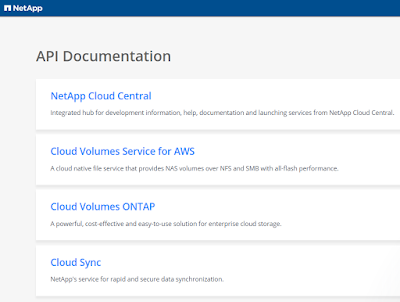
NetApp Kubernetes Service Demo
NetApp Cloud Volumes Service for AWS Demo

-